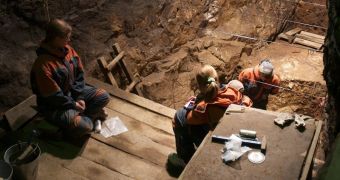According to the results of a recent DNA analysis conducted on ancient bone, it would appear that Neanderthals and our Homo sapiens ancestors intermingled freely more than 50,000 years ago. This finding helps explain why we still have traces of genetic material from Neanderthals in our genomes.
The study was carried out on a bone found in the remote Denisova Cave, in Siberia. Carbon-dating techniques have revealed that fossil to be around 50,000 years old, and to contain usable genetic material that scientists could work with, NPR reports.
The first bone to be used in this research belonged to a Neanderthal, and was found in 2010. Later on, a finger bone was found in the Denisova cave, followed by yet another bone, this time a toe. According to researchers, the second bone did not belong to neither of the two early human species, but rather to a third, called Denisovans.
Interestingly, genetic material harvested from the 2010 bone, and then sequenced in the lab, revealed numerous genetic similarities between Neanderthals and H. sapiens. Once the Denisovans' bone was found, scientists sequenced its genetic information as well.
What they found was amazing – the ancestors of the Neanderthals who used to own the toes (a female) – interbred freely with Denisovans before she was ever born. This naturally begs the question of whether or not H. sapiens mingled with Denisovans as well.
“It was a general pattern. There were a lot of cases of mixing. Not only that modern humans had a tendency to mix with the people they met when they spread across Eurasia, but these now extinct groups also mixed with each other – and [with] other groups,” says research Svante Paabo.
The expert, who holds an appointment as a researcher at the Max Planck Institute, in Germany, was the leader of the scientific team that made the findings. “There was some degree of promiscuity around,” he goes on to say.
A more in-depth analysis of Neanderthal DNA revealed patterns that did not belong to either H. sapiens or Denisovans. This confirms that Neanderthals interbred with other early human species, potentially including H. erectus, which evolved around 2 million years ago.
“As someone once said, ‘If a Neanderthal came and sat next to you on a bus, you'd probably get up and change seats. But if a Homo erectus came and sat next to you on a bus, you'd probably get off the bus’,” comments Montgomery Slatkin, a member of the research group, and a geneticist with the University of California in Berkeley.
The Neanderthal female fossil also revealed that the woman had parents who were inbred. This may be due to relatively low populations, which would have presented the poor souls with no other alternative except mate with each other. This may also explain their promiscuity.

 14 DAY TRIAL //
14 DAY TRIAL //